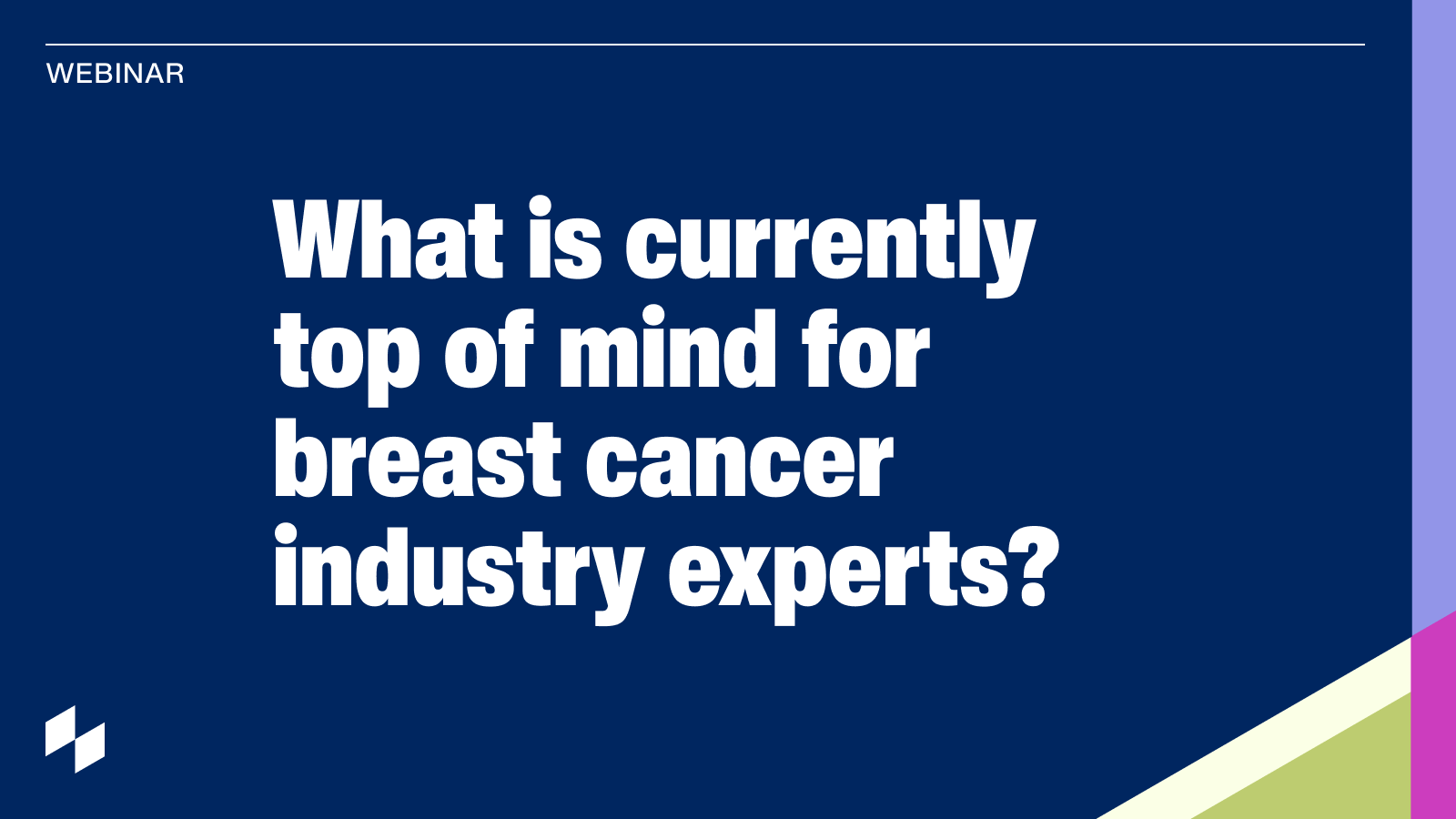The breast cancer treatment landscape is evolving rapidly — from the availability of new targeted treatment options, to the potential of AI to transform clinical trials and data management, and much more.
There are many reasons to be excited about the future of breast cancer research, but it is important for clinicians and researchers to understand how these advances could impact patient care and simplify complex clinical decision-making.
It’s also critical to address the obstacles lying in the way of accelerating progress and ultimately improving patient outcomes and quality of life.
A recent webinar hosted by Flatiron Health brought together experts across the healthcare ecosystem including clinical research, drug commercialization, and clinical practice to discuss the pressing challenges in breast cancer care as well as the most promising innovations on the horizon.
Promising advances in breast cancer treatment
Breast cancer is a heterogeneous disease, and can therefore be complicated to treat, particularly in its more advanced stages. However, the treatment landscape is constantly changing, and researchers and clinicians continue to explore new therapies and refine treatment combinations.
Neoadjuvant therapy is a top area of focus, noted Dr. Iuliana Shapira, MD, Chief Medical Officer at Regional Cancer Care Associates. Historically, administering chemotherapy or another targeted agent would allow physicians to make an inoperable tumor operable. “But neoadjuvant therapy has evolved substantially,” Dr. Shapira explained. “Today, we use it for all locally advanced inoperable cancer, for all triple negative or HER2 positive breast cancers that are larger than two centimeters, and for all high-risk hormone receptor positive, HER2 negative patients.”
Angela DeMichele, MD, MSCE, FASCO, Mariann T. and Robert J. MacDonald Professor in Breast Cancer Research at the University of Pennsylvania, believes circulating tumor DNA (ctDNA) shows tremendous potential as well, particularly in identifying patients who might have residual disease after completing treatment – which has been a major problem in the breast cancer treatment space, according to Dr. DeMichele. “We give very aggressive therapies, like neoadjuvant therapy, and we know that patients who get a complete pathologic response have a great prognosis, but it’s always a predictor, not a real-time assay” she said. “What ctDNA allows us to do is find exactly those patients who are at imminent risk of relapse so that we can try to make sure that we’re doing additional interventions…with a biomarker that can be tested in real-time”.
ctDNA is an area of research Flatiron has focused on enabling, either through retrospective real-world data capture and as part of prospective studies, because of its potential to non-invasively monitor breast cancer response to therapy, guide treatment decisions, or improve patient selection in clinical trials.
“I think [ctDNA] is going to open up a whole new area of research and ultimately change our treatment paradigm to be able to monitor patients in real time and potentially intervene before they become metastatic,” Dr. DeMichele added.
On the drug development side, we are seeing encouraging efforts to de-escalate treatment and improve patient quality of life, according to Neelima Denduluri, MD, FASCO, who serves as the Global Clinical Head of Breast Cancer R&D for AstraZeneca. She referenced a recent study that showed that some breast cancer patients have biomarkers that may signal that chemotherapy will not be effective. Knowing this could spare them from fertility loss and other negative effects of chemo. “As we’re developing drugs, it’s really important that we integrate those biomarkers— not only of response, but also of toxicity,” said Dr. Denduluri.
Biomarkers and treatment stratification factors are a focal point for Flatiron as well, particularly as they relate to understanding when to intensify or deescalate treatment. As Flatiron’s Emily Castellanos, MD, MPH, Senior Medical Director at Flatiron Health pointed out, this is one area where real-world data from Flatiron’s network of over 730,000 breast cancer patients can play an important role.
Tackling increasingly complex clinical decision-making
While clinical trials today are moving quickly and uncovering new answers, physicians are still charged with making complex decisions regarding each patient’s care. “With all of the new options for therapy and understanding more of the biology of the disease comes an increase in the complexity of deciding which therapy is best for which patient,” said Dr. DeMichele. Biomarkers are key to helping determine the right sequencing of treatments, though more research is needed. “It’s complicated to design trials to answer the question of whether there are optimal sequences,” she said. “So, in the absence of data about the best order of treatments, we are sort of trying to tailor our order to… the biomarkers that the patient’s tumor is expressing.” Demographics and other factors can also help illuminate the best way forward.
“That’s where I think we’re going to use both clinical trial data and real-world data to help us figure out how to apply the data to an individual patient,” said Dr. DeMichele.
The use of real-world evidence and integrating research and data into electronic health records could also help physicians make treatment decisions, noted Dr. Denduluri. As Dr. Denduluri pointed out, integrating real-world evidence is also critical for clinical trial design, especially in global trials where the standard of care may be different in different countries.
The potential, and challenges, of molecular testing
Molecular testing has become a cornerstone in decision-making for treating breast cancer. In the community oncology space, Dr. Shapira noted that biomarkers help determine better treatment paths for patients with metastatic breast cancer and can improve patient outcomes.
Additional research is underway to fully understand existing biomarkers—including in the adjuvant setting—and to uncover new biomarkers, according to Dr. DeMichele. Dr. DeMichele also sees potential in biomarker research beyond molecular testing, such as FES-PET scans: “I think that using both molecular testing and non-invasive imaging together could give us the best idea of what therapies a patient could respond to and importantly, which therapies a patient won’t respond to.”
One challenge that remains with molecular testing raised by Dr. Denduluri is the need to standardize testing methods, as a patient who has already been tested for a biomarker may need to be re-tested to enroll in a clinical trial. Since testing can be invasive, this poses challenges for the patient and the clinical trial teams. “While the challenges for enrollment standardization are there, I think everyone is thinking, how can we solve this issue?” noted Dr. Denduluri.
Novel approaches to trial design and execution – and barriers to success
While clinical trials are essential to advancing research, it can take a significant amount of time for a trial to run and for the results to be shared broadly. Dr. Castellanos cited simplifying study designs, reducing data collection requirements, and expanding community-based clinical research as just a few ways that clinical trials can be improved.
Designing more inclusive trials is of top importance, said Dr. Denduluri. “Many of us, including AstraZeneca, have a clinical trial diversity task force that is making sure to have a diversity plan at the outset of a trial, including picking sites that serve the underserved populations.”
Conducting trial visits remotely and reevaluating eligibility criteria is also important. As Dr. Shapira discussed, AI and other technologies can be useful in addressing some of these challenges. For example, AI can be used to help match patients to clinical trials based on eligibility and the biomarker or patient population the trial is targeting.
The promise of AI in breast cancer research and clinical practice
In addition to clinical trial design and enrollment, AI has an enormous amount of potential in the breast cancer space. Dr. DeMichele discussed how AI can be used in pathology to better understand the heterogeneity of tumors, predict treatment outcomes and more. “It could be that there are features that we never knew would be predictive of outcomes, but because of machine learning, we can investigate a lot of additional variables that ultimately could be very helpful to us.”
Dr. DeMichele also anticipates that AI will impact imaging, helping radiologists identify higher risk patients and reduce the amount of false positives in screening. Finally, she believes AI can help patients navigate care. “I’m looking forward to navigation programs that can really help us to teach patients what they need to know for their therapies [and] give them less time in the hospital or clinic and more time with their families.”
Nevertheless, there are significant challenges that could impede the rollout of AI in breast cancer research and treatments. As Dr. Denduluri noted, concerns over patient confidentiality must be addressed.
At Flatiron, teams are examining the potential of AI across a range of use cases, including how to use machine learning to scale data, pull information from unstructured records to create larger data sets, and improve trail enrollment.
With so much promise on the horizon, it’s an exciting time for the breast cancer space
Advancements in breast cancer research are already leading to more tailored and effective treatment paths for patients, and more progress is underway in areas such as duplex sequencing, bispecific antibodies, and other new agents.
“All of these techniques are phenomenal and are developing right before our eyes,” said Dr. Shapira. “Without AI and without the ability to study large data, we would not be here.”
With a network of over 730K breast cancer patients spanning early and metastatic disease settings, Flatiron can power more breast cancer studies than ever before with cohorts that enable greater breadth and depth of analysis. To learn more about how we can support breast cancer research across the therapeutic development lifecycle, reach out to us.


